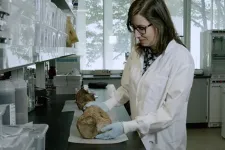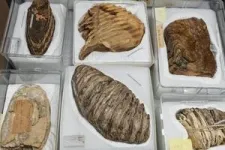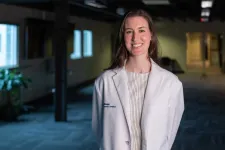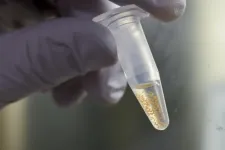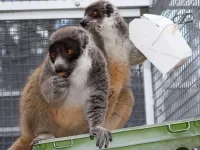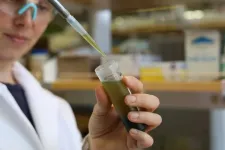(Press-News.org) Mammoths, the massive pre-historic ice age cousins of the modern-day elephant, have always been understood to have inhabited parts of British Columbia, but the question of when has always been a bit woolly.
Now, a new study from Simon Fraser University has given scientists the clearest picture yet when the giant mammals roamed Vancouver Island.
As part of SFU researcher Laura Termes’ PhD and published earlier this month in the Canadian Journal of Earth Sciences, the study examined 32 suspected mammoth samples collected on Vancouver Island. Of those samples, just 16 were deemed suitable for radiocarbon dating.
The youngest sample was found to be around 23,000 years old and the oldest turned out to be beyond the range radiocarbon dating could measure, meaning it was older than 45,000 years.
Prior to the study, only two mammoth remains found on Vancouver Island had ever been dated before. Both lived around 21,000 years ago, so the Termes’ study provides a greater understanding of when the massive mammals lived in the area.
“This is really exciting because it shows that mammoths have lived on Vancouver Island for a long time,” says Termes, a PhD candidate in the Department of Archaeology. “We were expecting similar results [to the two samples previously dated] but what we found were mammoths that were much older. It is fantastic that they could be preserved for that long.”
Termes says having the curatorial support at the Royal BC Museum and the Courtenay and District Museum and Palaeontology Centre allowing access to their collections was invaluable to the study.
“This research highlights the important role of museum collections for understanding how life has evolved and changed in British Columbia’s deep history,” says Victoria Arbour, curator of palentology at the Royal BC Museum. “It’s great to see Woolly’s relatives in the Royal BC Museum’s collections in the spotlight through this research study.”
The UBC ADaPT Facility (which was instrumental in helping determine if samples were indeed mammoths and not whales or other animals) also played an important role in the research, Termes says.
And archaeologists need all the help they can get because while mammoths were enormous, finding intact samples in British Columbia is actually quite rare.
“When we imagine great big giant animals of the last ice age being found, we might have imagined fully articulated and complete skeletons being systematically excavated. But in southern B.C., that simply does not happen,” says Termes. “Instead, we may get an isolated molar that's been tumbled around in the water for a long time, or maybe a piece of a tusk. And these are what everyday people are encountering.”
For example, one sample she examined was a piece of mammoth tooth found by a child in the gravel at a local playground.
“So maybe it’s a dog owner, taking their puppy for a walk on a rainy day, or a gravel pit operator at work,” says Termes, who grew up in Qualicum Beach. “I really like how these magnificent animals are finding their way into people's lives in routine and everyday ways.”
Termes says the study is part of a larger look at megafauna in B.C. and she plans on radiocarbon dating mammoth samples from other parts of the province.
AVAILABLE SFU EXPERTS
LAURA TERMES, PhD candidate, archaeology
250.816.1684 | laura_termes@sfu.ca
VICTORIA ARBOUR, curator of palaeontology, Royal BC Museum
250.896.0217 | varbour@royalbcmuseum.bc.ca
CONTACT
MATT KIELTYKA, SFU Communications & Marketing
236.880.2187 | matt_kieltyka@sfu.ca
Simon Fraser University
Communications & Marketing | SFU Media Experts Directory
778.782.3210
ABOUT SIMON FRASER UNIVERSITY
Who We Are
As Canada’s engaged university, SFU works with communities, organizations and partners to create, share and embrace knowledge that improves life and generates real change. We deliver a world-class education with lifelong value that shapes change-makers, visionaries and problem-solvers. We connect research and innovation to entrepreneurship and industry to deliver sustainable, relevant solutions to today’s problems. With campuses in British Columbia’s three largest cities—Vancouver, Burnaby and Surrey—SFU has eight faculties that deliver 364 undergraduate degree programs and 149 graduate degree programs to more than 37,000 students. The university now boasts more than 180,000 alumni residing in 145+ countries.
END
When mammoths roamed Vancouver Island: SFU and Royal BC Museum delve into beasts’ history in our region
2024-08-07
ELSE PRESS RELEASES FROM THIS DATE:
Ochsner Health welcomes Mary Claire Curet, MD, as first Ochsner Physician Scholar
2024-08-07
Lafayette, La. – Ochsner Health is excited to announce that Mary Claire Curet, MD, is joining the team at St. Martinville Family Medicine, an Ochsner primary care practice. Dr. Curet, a native of New Iberia, is the first Ochsner Physician Scholar and brings a wealth of knowledge and a deep commitment to her community.
“We are thrilled to welcome Dr. Curet to the Ochsner family,” said Leonardo Seoane, MD, Founding Dean of Xavier Ochsner College of Medicine and Executive Vice President and Chief Academic Officer for Ochsner Health. “Her dedication and passion for primary care, particularly in underserved ...
Discovering how plants make life-and-death decisions
2024-08-07
Researchers at Michigan State University have discovered two proteins that work together to determine the fate of cells in plants facing certain stresses.
Ironically, a key discovery in this finding, published recently in Nature Communications, was made right as the project's leader was getting ready to destress.
Postdoctoral researcher Noelia Pastor-Cantizano was riding a bus to the airport to fly out for vacation, when she decided to share a promising result she had helped gather a day earlier.
“I didn’t want to wait ten days until I came back to send it. It took almost two years to get there,” said Pastor-Cantizano, who then worked ...
National Academies progress report: Health disparities
2024-08-07
Irvine, Calif., Aug. 7, 2024 — From costing society an estimated $11 trillion to hindering new discoveries in medicine and preventing access to effective interventions, underrepresentation of women, older adults and minorities in clinical research has several significant consequences, according to recent analyses commissioned by the National Academies of Sciences, Engineering and Medicine.
Jonathan Watanabe, UC Irvine professor of clinical pharmacy practice and director of the campus’s Center for Data-Driven Drugs Research and Policy, ...
Lemurs use long-term memory, smell, and social cues to find food
2024-08-07
How do foraging animals find their food? A new study by New York University researchers shows that lemurs use smell, social cues, and long-term memory to locate hidden fruit—a combination of factors that may have deep evolutionary roots.
“Our study provides evidence that lemurs can integrate sensory information with ecological and social knowledge, which demonstrates their ability to consider multiple aspects of a problem,” said anthropologist Elena Cunningham, a clinical professor of molecular pathobiology at NYU College of Dentistry and the lead author of the study, published in the International Journal of Primatology.
Animals rely on ...
New research challenges conventional wisdom on wet surface adhesion
2024-08-07
Scientists at the University of Akron and the University of Pittsburgh have overturned long-held assumptions in new research that finds water can be a help for adhesion.
Dr. Ali Dhinojwala, distinguished W. Gerald Austen Endowed Chair and H.A. Morton Professor at The University of Akron’s School of Polymer Science and Polymer Engineering, lead a team whose significant breakthrough — that water can unexpectedly enhance adhesion under controlled conditions — was published Aug. 7 in Science Advances.
The implications of this research are profound, particularly in biomedical applications ...
Newly published report outlines findings from first archaeology project in space
2024-08-07
The first-ever archeological survey in space has provided new insights into how astronauts use and adapt their living space on the International Space Station, which could influence the design of new space stations after the ISS is decommissioned.
Findings from the research team behind the International Space Station Archaeological Project (ISSAP) were published today in the journal PLOS ONE. Archaeologist Justin Walsh of Chapman University is available to discuss the discoveries of the team’s first on-orbit project, the Sampling Quadrangle Assemblages Research Experiment (SQuARE).
While Earth-bound archaeologists dig one-meter squares to understand ...
Memory loss in aging and dementia: Dendritic spine head diameter predicts memory in old age
2024-08-07
BIRMINGHAM, Ala. – Over the course of life, memory fades with varying degrees, robbing older people of the ability to recollect personal experiences. This progressive, nearly inevitable process has long been hypothesized as a consequence of nature’s removal of dendritic spines, a key component of synapses, from brain neurons as they age.
A study published in Science Advances led by researchers at the University of Alabama at Birmingham and Rush University Medical Center, Chicago, Illinois, now provides evidence that the preservation of past life experiences ...
Birmingham host to investigational treatment trial which could improve outcomes of pregnancies affected by severe haemolytic disease
2024-08-07
Pregnant mothers have taken part in a clinical study (the UNITY trial) in Birmingham, which has found that nipocalimab, an investigational, fully human, monoclonal antibody, has the potential to improve the survival rate of unborn babies with rare, early-onset fetal anaemia, as a result of haemolytic disease of the fetus and newborn (EOS-HDFN).
The study investigated pregnancies complicated by severe EOS-HDFN (RhD (D) or Kell (K) alloimmunized pregnant individuals with singleton pregnancies) and evaluated the effects of nipocalimab at weekly intervals from 14-35 ...
Drug trial for rare fetal blood disease shows promise for less invasive approach
2024-08-07
AUSTIN, Texas — Data from a new investigational drug that could alter the standard treatment for a rare blood disease suggests it has the potential to delay or prevent anemia and the need for intrauterine blood transfusions in babies who are at high risk for the condition, known as Hemolytic Disease of the Fetus and Newborn (HDFN). Results of the Phase 2 clinical trial of the drug nipocalimab were published today in The New England Journal of Medicine.
HDFN is a serious condition in which the blood types of the mother and her fetus do not match, potentially causing life-threatening anemia in the baby. The current ...
Forever chemical pollution can now be tracked
2024-08-07
Organofluorine compounds — sometimes called ‘forever chemicals’ — are increasingly turning up in our drinking water, oceans and even human blood, posing a potential threat to the environment and human health.
Now, researchers at The University of Texas at Austin have developed a way to fingerprint them, which could help authorities trace them to their source when they end up in aquifers, waterways or soil.
The technique involves passing samples through a strong magnetic field then reading the burst of radio waves their atoms emit. This reveals ...
